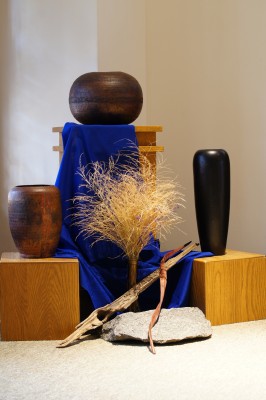John 4: 1-42
The Scriptures for this weekend are rich with many themes: water and baptism, the forgiveness of sins, God’s providential care, and salvation going out to all peoples. Despite their richness, I sought only one thing: to understand this woman to whom Jesus spoke at Jacob’s well. The results of my study surprised me, and so my talk is titled, “Five Women at the Well.”
The sinful woman One interpretation of this story predominates in our day. It presumes that a woman would not come alone to draw water in the heat of the day unless she were an outcast. When Jesus names her past – a woman with five former husbands living with a man – the story is read in parallel to those of the woman caught in adultery, or the woman whose tears washed Jesus’ feet. She is seen as an adulterous woman, a sinner. In offering her the living water, Jesus is offering forgiveness and a new start in life. He offers salvation – which he says comes through the Jews – even to an outsider. For this reason, the catechumens preparing for Baptism are given this passage to study and ponder.
The survivor woman But what if the woman at the well was not a notorious adulteress? Lynn Cohick asked this question while teaching and living in Kenya. The school bought its vegetables from Florence, a young mother of two sons. Lynn discovered that Florence’s husband had died when her children were young, and her parents sought a suitable spouse who would care for the children as his own. Initially against her will, they chose a very elderly man whose own children had died. Florence now saw their wisdom, appreciating the wisdom of her nearly blind and deaf husband whose farmland enabled her to provide for the family and to give an inheritance to the children. Perhaps, she thought, there might be a third husband someday, when she was in her 30s, who would be the partner of her adult life.
Florence’s story prompted Lynn Cohick to consider the woman at the well in a different light. Had she been widowed by illness or war? Had her family chosen badly, marrying her into difficult situations? Was she given to an elderly man in marriage? Or perhaps her family was poor, unable to produce a desirable dowry, so that she was now unable to marry at all?
Through Florence’s story, Cohick recognized that the Scriptures do not present the woman as a notorious sinner. She discovered that, until the reformation, commentators and scholars did not view her this way. Perhaps Jesus saw a life of suffering and hardship in her five husbands and current status, not so different from Joseph whose bones were buried nearby. He offers her the living water of hope in salvation and newness of life.
The skeptical woman The conversation between Jesus and this woman at the well is undeniably remarkable, not only because it occurred between a Samaritan and a Jew, a man and a woman.
The woman is feisty. She sees a thirsty man in the heat of the day, yet questions why he asks her for water. Jesus counters that, if she knew who he was, she would have asked that he give her living water. The woman is skeptical. “Where is your bucket? And do you think you are greater than Jacob, who gave us this well?” The discussion that follows, about the proper place of worship, sounds like so much evasion to modern ears: a skeptical person side-stepping a true encounter with Jesus.
The Samaritan woman is not the first skeptical person presented in John’s Gospel. Told about Jesus, Nathanael dismissively asked Philip, “Can anything good come out of Nazareth?” Like this woman, Jesus tells Nathanael about himself.
For both the Samaritan woman and Nathanael, Jesus’ knowledge about them is the point that turns them from skeptics into believers. And to each Jesus speaks of eternal life. He promises Nathanael he will see heaven opened and the angels of God ascending and descending. He tells the woman at the well that the time is coming when she will worship neither in Samaria nor in Jerusalem, but instead will worship in spirit and in truth. To her, he goes on to declare himself to be the Messiah, for whom the Samaritans too are waiting.
This woman is bold, unafraid, and open to hear Jesus’ message but also ready to test its validity. Jesus welcomes her in her active search for God.
The spiritual woman Scholars from the Israel Institute of Biblical Studies offer another view of this woman . While the Gospels consistently present a negative image of the Samaritans as held by the Pharisees, in Jesus’ time, Dr. Eliyahu Lizorkin-Eyzenberg shows us how the Samaritans viewed themselves.
Flying past a long and complicated history in Old Testament times, the people of Samaria traced their ancestry to the patriarch Jacob. They lived in the land Jacob gave to Joseph, the place where Joseph was buried. The Samaritans held to the books of Moses as Scripture. They worshipped on Mt. Gerizim, the first site of sacrifice in the Holy Land and center of worship for all the patriarchs. The Samaritans saw the Jews (Judea-centered believers) as people who introduced novelties into worship, brought back from their foreign exiles. The unbroken line of Levitical priests in the Samaritan temple on Mt. Gerizim were, in the view of the Samaritans, the rightful leaders of the descendants of Abraham, Isaac, and Jacob. They, too, awaited the Messiah who would set all things right.
Now we hear this Samaritan woman’s question with new ears. Jesus, a Jew, has told her “everything she has done” and offered her the gift of “living water.” She sees him as a prophet of God. But can she believe him? Is he truly of God? Her question about the place of worship is not evasive or abstract: it is the question of a seeker who wants to believe. Jesus declares the “true” worship of the Father “in spirit and in truth” that does not depend on place or sacrifice. When the woman professes her belief in Messiah, Jesus reveals himself to her, openly declaring, “I am he.”
This woman of Samaria then becomes an apostle to her city. Many believed because of the strength of her testimony. Jesus stayed with them, in Samaria, for two days. Many in this separated, despised territories came to believe that Jesus was “truly the Savior of the world” through the conversion of this one woman.

The Samaritan woman after Jesus left This Gospel story, like so many, has no ending. Like the man born blind, the Centurion’s servant, the man lowered through the roof, or the woman bent double, the Gospel neither names this woman nor tells us anything of her life after her encounter with this Jewish Messiah. Jesus stays two days in Sichar, teaching and preaching. Many who came out to hear him because of the woman’s testimony also come to believe that he is the Messiah – come from the Jews, not the Samaritans as they expected. Jesus continues on his way, back into the familiar territory of the Jews. How could the woman, or any of these Samaritan believers, become disciples and followers within the hostile Jewish culture? Yet how could they meet the Messiah and simply watch him walk away?
Tradition gives us a bit more story. The Roman Martyrology lists the martyrdom of St. Photina, a woman of Samaria, along with her companions: Joseph and Victor, her sons, Sebastian, Victor’s superior officer in the Roman army, and family members. In this tradition, Photina became a powerful preacher of the Gospel even as far as Carthage in North Africa; the others were converted through her influence. Her memorial was dropped from the Roman calendar in 1969; it used to be celebrated on March 20. The Orthodox churches continue to celebrate St. Photina and her companions on February 26.
Who is this woman at the well? We have seen her as sinner, suffering survivor, skeptic, spiritual seeker, and martyred saint. In each of these five women at the well, there is something that we can learn, something to emulate – Jesus enduring gift of eternal life through the living waters.
